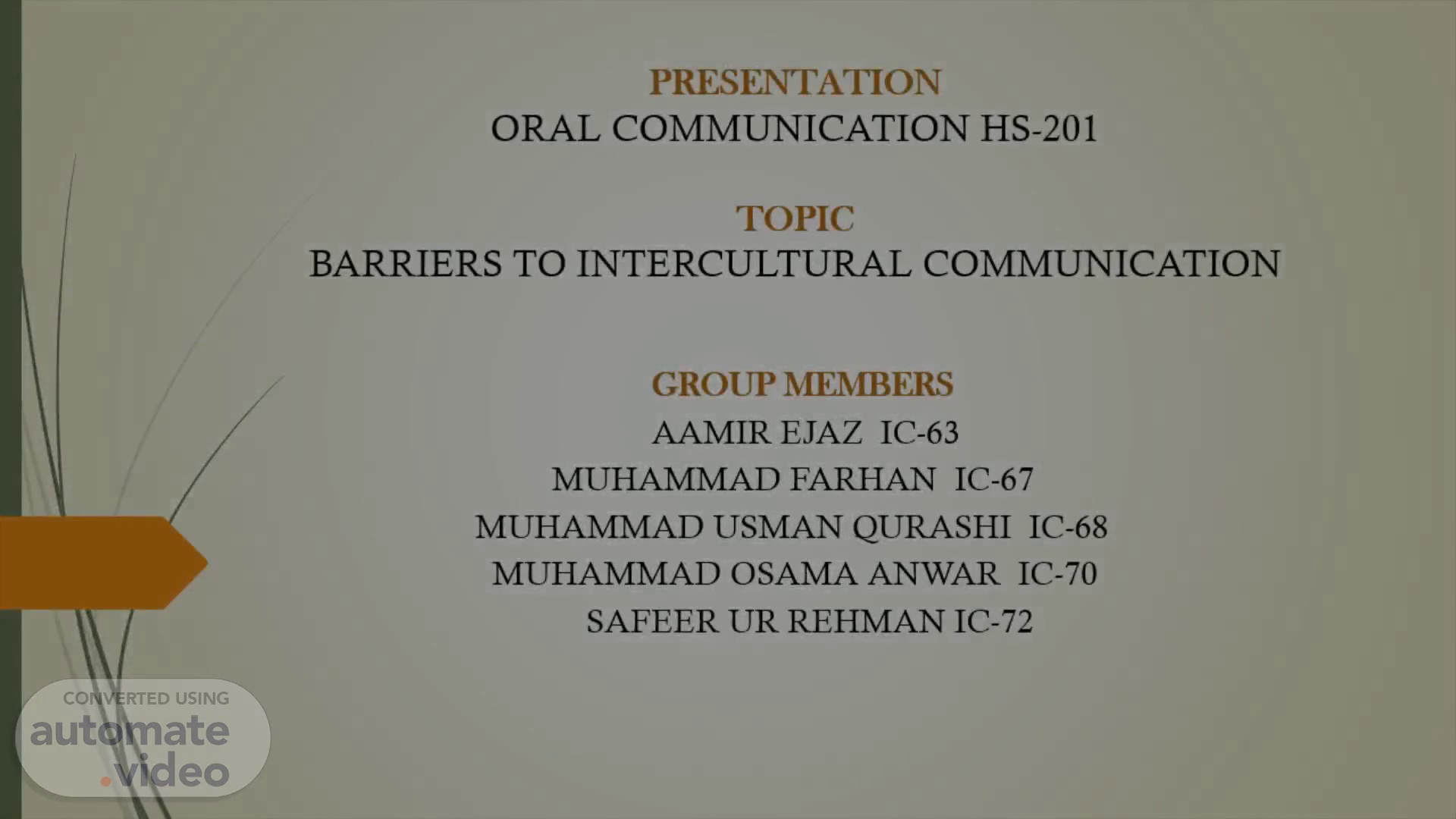
PRESENTATION ORAL COMMUNICATION HS-201 TOPIC BARRIERS TO INTERCULTURAL COMMUNICATION
Scene 1 (0s)
PRESENTATION ORAL COMMUNICATION HS-201 TOPIC BARRIERS TO INTERCULTURAL COMMUNICATION.
Scene 2 (4s)
BARRIERS TO INTERCULTURAL COMMUNICATION. INTRODUCTION Effective communication is a skill that few people posses and even fewer people can get their point across when there is a cross cultural barrier. Cross cultural or intercultural communication is a part of the interaction of different people from different backgrounds and heritages. Most of us can appreciate the importance of intercultural communication, yet several stumbling blocks may get in the way of a positive intercultural communication experience. Some of them are anxiety, stereotyping, prejudice, assumption of similarities language as a barrier etc..
Scene 3 (51s)
1. ANXIETY IN INTERCULTURAL COMMUNICATION Anxiety is usually defined as a state of human condition where a person has a feeling of unease and nervousness. Anxiety usually occurs when a person usually comes across his first cross cultural interaction. The feeling of not knowing what to expect from their counterparts and lack of any knowledge about the ways to interact with them usually causes a great deal of anxiety in individuals. The best way to tackle such anxiety is to obtain as much knowledge about the culture of the opposite party as possible. By obtaining information before hand anxiety can significantly be reduced and a proper interaction can be made..
Scene 4 (1m 12s)
2. ETHNOCENTRISM AS A BARRIER TO INTERCULTURAL COMMUNICATION Ethnocentrism is a perception that an individual has for someone else’s culture and heritage as being inferior to his or her own culture and heritage. Ethnocentrism is mostly carried out unintentionally where one is not aware of the fact that what they are doing may cause cultural and communication barriers. However, dealing with ethnocentrism is quite simple by respecting the differences of cultures can significantly reduce the feeling of ethnocentrism amongst the people. The second step is raising awareness amongst people of different customs of other cultures..
Scene 5 (2m 52s)
3. STEREOTYPES IN INTERCULTURAL COMMUNICATION Stereotypes are oversimplified ideas about groups of people. Stereotypes can be based on race, ethnicity, age, gender, sexual orientation almost any characteristic. They may be positive, such as all Asian students are good at math, but are most often negative, such as all overweight people are lazy. Stereotypes are frequently expressed on TV, in movies, chat rooms and blogs, and in conversations with friends and family. Treating individuals according to rigid stereotypic beliefs is detrimental to all aspects of the communication process and can lead to prejudice and discrimination..
Scene 6 (5m 14s)
4 . CULTURAL RELATIVISM Cultural relativism is another most notable barrier of intercultural communication. The denial of others’ values and cultures for the augmentation of self values and cultures refers to cultural relativism. Cultural relativism is a notion that reflects the superiority of a certain group. The denial of others values makes cultural relativism a prominent barrier of cross-cultural communication. It is the same like imposing your conceptions on others’ morals and conceptions. The concept of cultural relativism is mostly found in UAE small and medium enterprises, where employees are kept on to the adaptation of the static culture..
Scene 7 (6m 48s)
5 . LANGUAGE AS A BARRIER TO INTERCULTURAL COMMUNICATION Language is an exchange gate of communication. It refers to a source which exchanges values, ideas, and thoughts between two exchange groups. If exchange groups are cross cultural, definitely language can be a major barrier of exchange. L anguage barriers can be removed by hiring specialists. Specialists in areas of cross-cultural communication can be effective to remove language barriers. S pecial training programs can be organized to improve speech tendency and language frequency of the speaker. This is how language barriers can be minimized and controlled for effective intercultural communication ..
Scene 8 (8m 38s)
THANK YOU.